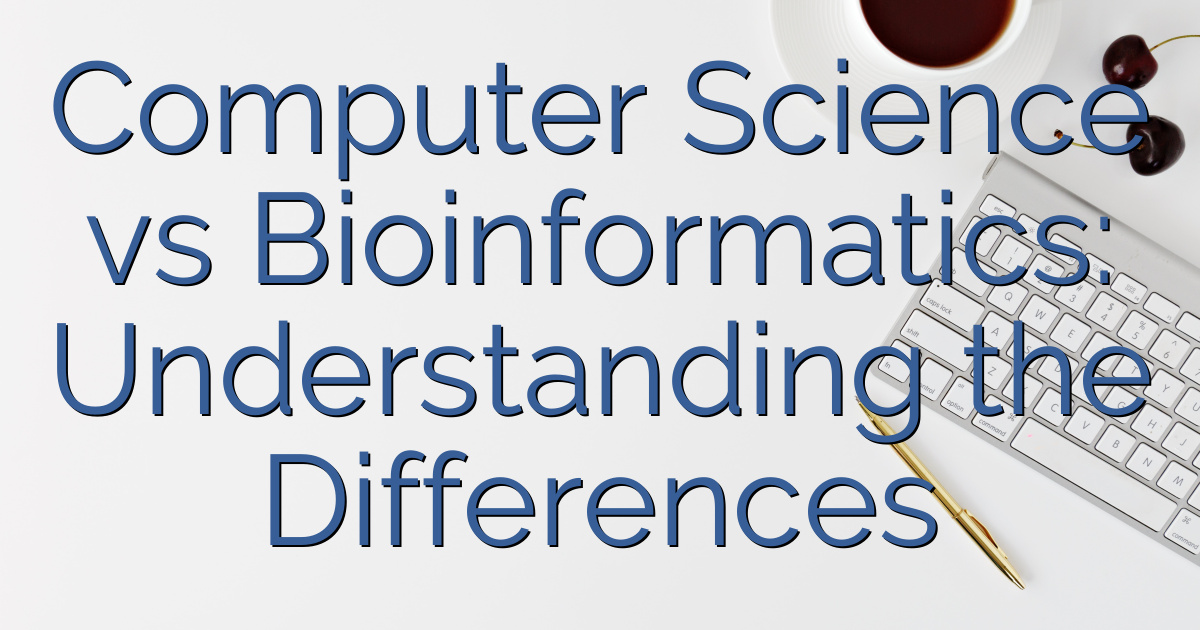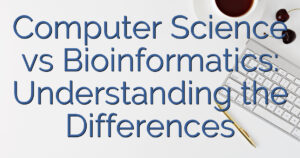
Computer Science and Bioinformatics are two rapidly growing and evolving fields that have gained significant attention in recent years.
While both fields are rooted in computer science, they differ in their approach, scope, and application.
Computer science involves the study of algorithms, programming languages, and computing systems, while bioinformatics focuses on the analysis and interpretation of biological data using computational methods.
Computer science has been around for several decades and has become an integral part of modern society. It has impacted various industries, from finance to healthcare, and has revolutionized the way we live and work.
Computer science professionals work on developing software, designing computer systems, and creating algorithms that can automate complex tasks.
They are in high demand due to their expertise in programming languages, database management, and software engineering.
Bioinformatics, on the other hand, is a relatively new field that emerged in the 1990s.
It involves the application of computer science, statistics, and mathematics to biological data analysis and interpretation.
Bioinformatics professionals work on developing algorithms, tools, and databases that can help researchers analyze and interpret complex biological data.
They play a crucial role in fields such as genomics, proteomics, and drug discovery.
Table of Contents
Key Takeaways – Computer Science vs Bioinformatics
- Computer Science and Bioinformatics are two distinct fields that differ in their approach, scope, and application.
- Computer Science involves the study of algorithms, programming languages, and computing systems, while bioinformatics focuses on the analysis and interpretation of biological data using computational methods.
- Both fields have impacted various industries and are in high demand due to their expertise in programming languages, database management, and software engineering.
Understanding Computer Science
Fundamentals of Computer Science
Computer Science is the study of computers and computational systems. It involves both theoretical and practical aspects of computing. Computer Science is based on the principles of mathematics, engineering, and science.
The fundamental concepts of Computer Science include algorithms, programming languages, data structures, and computer architecture. Algorithms are the step-by-step procedures used to solve problems. Programming languages are used to write instructions for computers to perform tasks. Data structures are the ways in which data is organized and stored in a computer. Computer architecture is the design of computer systems.
Applications of Computer Science
Computer Science has a wide range of applications in various fields, including business, healthcare, education, and entertainment. Some of the popular applications of Computer Science are:
- Artificial Intelligence (AI): AI is the simulation of human intelligence in machines. It involves the development of algorithms that can perform tasks that typically require human intelligence, such as visual perception, speech recognition, decision-making, and language translation.
- Robotics: Robotics is the design, construction, and operation of robots. Robots are used in various industries, including manufacturing, healthcare, and entertainment.
- Computer Networking: Computer networking is the process of connecting computers and other devices together to share resources and information. It involves the use of hardware and software to create and maintain networks.
- Cybersecurity: Cybersecurity is the protection of computer systems and networks from theft, damage, or unauthorized access. It involves the use of various techniques, such as encryption, firewalls, and intrusion detection systems, to protect computer systems.
Overall, Computer Science is a rapidly growing field that has a wide range of applications in various industries. It is an exciting field that requires a strong foundation in mathematics, engineering, and science.
Grasping Bioinformatics
Bioinformatics is an interdisciplinary field that combines biology, computer science, and statistics to analyze and interpret biological data. It involves the development of algorithms, software, and databases to store, retrieve, and analyze biological data. In this section, we will discuss the basics of bioinformatics and the utilization of bioinformatics in various fields.
Basics of Bioinformatics
Bioinformatics involves the use of computational tools and techniques to study biological systems at the molecular level. It includes the analysis of DNA, RNA, and protein sequences, as well as the prediction of their structure and function. Bioinformatics also involves the analysis of gene expression data, protein-protein interactions, and metabolic pathways.
To understand the basics of bioinformatics, it is important to have a basic understanding of biology, genetics, and statistics. Some of the key concepts in bioinformatics include sequence alignment, phylogenetic analysis, gene prediction, and protein structure prediction. These concepts are used to identify similarities and differences between biological sequences and to predict their function.
Utilization of Bioinformatics
Bioinformatics has become an essential tool in various fields, including medicine, agriculture, and environmental science. In medicine, bioinformatics is used to identify disease-causing mutations, to develop personalized medicine, and to analyze large-scale genomic data. In agriculture, bioinformatics is used to develop new crop varieties, to improve crop yields, and to study the effects of climate change on crops. In environmental science, bioinformatics is used to study microbial communities, to monitor pollution, and to predict the impact of climate change on ecosystems.
Bioinformatics has also become an important tool in drug discovery and development. It is used to identify potential drug targets, to design new drugs, and to predict the toxicity of drugs. In addition, bioinformatics is used to analyze the data generated by high-throughput screening, which involves testing large numbers of compounds for their biological activity.
Overall, bioinformatics has revolutionized the way we study and understand biological systems. It has become an essential tool in various fields, and its applications are only expected to grow in the future.
What are the main differences between Bioinformatics and Computer Science?
Bioinformatics and computer science have distinct focuses. Bioinformatics incorporates biological data analysis by utilizing algorithms and software tools. On the other hand, computer science emphasizes the study of computation and programming, covering various applications beyond biology. The main difference lies in their subject matter and the domain-specific knowledge required for bioinformatics compared to the broader scope of computer science vs software engineering.
How Does Bioinformatics Differ from Biotechnology and Molecular Biology in the Field of Computer Science?
Bioinformatics focuses on the use of computer science to analyze and interpret biological data, while biotechnology and molecular biology involve manipulating biological systems for applications in various fields. The difference between biotechnology and molecular biology lies in their approach to the study and use of biological processes.
Computer Science vs Bioinformatics
Comparative Analysis
Computer Science and Bioinformatics are two different fields that have some similarities and differences. Both fields deal with data analysis, but the types of data analyzed differ greatly. Computer Science is more focused on the development of software, hardware, and algorithms, while Bioinformatics is more focused on analyzing biological data using computational methods.
In terms of education, Computer Science programs typically require more math and programming courses, while Bioinformatics programs require more biology and statistics courses. Computer Science students may also have more opportunities to specialize in different areas such as artificial intelligence, machine learning, and cybersecurity, while Bioinformatics students may specialize in genomics, proteomics, or systems biology.
Career Opportunities in Both Fields
There are many career opportunities in both Computer Science and Bioinformatics. Computer Science graduates can work as software developers, network administrators, database administrators, cybersecurity analysts, and more. Bioinformatics graduates can work as bioinformaticians, computational biologists, data analysts, and more.
The demand for professionals in both fields is high, and the job outlook is positive. According to the Bureau of Labor Statistics, employment in computer and information technology occupations is projected to grow 11 percent from 2019 to 2029, much faster than the average for all occupations. The field of Bioinformatics is also growing rapidly, with many job opportunities in academia, government, and industry.
In summary, both Computer Science and Bioinformatics are promising fields with unique opportunities and challenges. Choosing between them depends on one’s interests, skills, and career goals.
Impact on Society
Computer Science’s Societal Influence
Computer Science has had a significant impact on society. It has revolutionized the way people communicate, work, and entertain themselves. The widespread use of computers has led to the creation of new industries, such as e-commerce, social media, and online gaming. Computer Science has also made significant contributions to fields such as medicine, engineering, and education.
Computer Science has enabled researchers to develop new technologies that have improved the quality of life for millions of people. For example, Computer Science has played a vital role in the development of advanced medical imaging techniques, such as MRI and CT scans. These technologies have enabled doctors to diagnose and treat diseases more accurately and effectively.
Computer Science has also played a significant role in improving education. The use of computers in the classroom has enabled students to access information and learn at their own pace. Computer Science has also led to the development of online education platforms, which have made education more accessible to people around the world.
Bioinformatics’ Societal Influence
Bioinformatics has had a significant impact on society. It has revolutionized the way researchers study and understand biological systems. Bioinformatics has enabled researchers to analyze large amounts of data, such as DNA sequences, and identify patterns and relationships that would be impossible to detect manually.
Bioinformatics has played a vital role in the development of new drugs and treatments for diseases. Researchers use bioinformatics tools to identify potential drug targets and design drugs that are more effective and have fewer side effects. Bioinformatics has also played a significant role in personalized medicine, which involves tailoring medical treatments to an individual’s genetic makeup.
Bioinformatics has also had a significant impact on agriculture. Researchers use bioinformatics tools to study plant genomes and develop new crop varieties that are more resistant to pests and diseases. Bioinformatics has also enabled researchers to develop more efficient and sustainable farming practices, which can help feed a growing global population while minimizing the impact on the environment.
Overall, both Computer Science and Bioinformatics have had a significant impact on society. They have enabled researchers to develop new technologies, improve medical treatments, and develop more sustainable farming practices. As these fields continue to evolve, they are likely to have an even greater impact on society in the future.
Future Trends
Computer Science Trends
As technology advances, computer science is expected to continue to play a vital role in the future of bioinformatics. One trend that is expected to continue is the use of machine learning algorithms to analyze large data sets. This will enable researchers to identify patterns and relationships in the data that might be difficult or impossible to detect using traditional statistical methods.
Another trend in computer science that is expected to impact bioinformatics is the development of more powerful and efficient computing systems. This will enable researchers to process and analyze larger data sets more quickly and with greater accuracy.
Bioinformatics Trends
In the coming years, bioinformatics is expected to continue to grow and evolve as new technologies and techniques are developed. One trend that is expected to continue is the use of high-throughput sequencing technologies to generate large amounts of genomic data. This will enable researchers to better understand the genetic basis of disease and develop more effective treatments.
Another trend in bioinformatics is the development of new tools and techniques for analyzing and interpreting genomic data. For example, researchers are working on developing new algorithms for identifying disease-causing mutations in the genome. These tools will enable researchers to more quickly and accurately diagnose genetic diseases and develop targeted treatments.
Overall, the future of bioinformatics is likely to be shaped by advances in both computer science and biology. As these two fields continue to converge, new opportunities for research and discovery are likely to emerge, leading to new insights into the genetic basis of disease and new treatments for a wide range of conditions.
